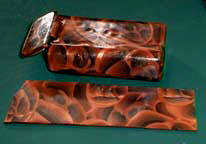There are a couple of places where air can be captured
when we work with polymer
clay.
When conditioning the clay we can get air trapped in a number of ways. I use
a
food processor to chop up and warm the clay. The chopped up clay is all
pebbly.
I have to take care when compressing those chunky pebbles to ease out the
air
that exists between the clay chunks. I take the clay chunk and start from
one
end and slowly compress the clay going to the other end of the lump of clay.
I
like to think that eases more air out of the clay pebbles. You don't know
for
sure until you press that conditioned clay into sheets.
When you press conditioned clay into sheets and if you see air trapped pop
it
with the tip of an exacto knife and ease the air out. The thin settings of
the
pasta machine will help you see the air bubbles better, not too thin though.
When you fold the clay sheet again to press it more take care in how you
fold as
to not trap more air bubbles in the process, for example, when folding a
clay
sheet in half you always put the folded end of the sheet into the rollers to
prevent air from being trapped.
When making blends one can trap air bubbles. The only way we can deal with
that is to pop them like air zits. Pop the air bubble and press out the air.
Fold
your blend sheet up again and run it through the pasta machine. Keep on
pressing the sheet until all the air bubbles have been popped.
When building canes if we don't make sure that the different sections of the
cane are butt up flush against what is next to it, the gap will show when
you
slice the cane. If we're layering cane slices that gap could turn into an
air
bubble. If the gap doesn't show then the design will distort because the
clay
eased into the gap, giving your Mona Lisa face cane a big fat booger under
her
nose, not happy.
Bottom line with canes is to make sure that the various elements of the cane
are flush against their neighbor.
When applying a sheet to a flat surface you can get air bubbles. We have to
apply sheets to a flat surface like folks apply wall paper: start it from
one
end and smooth the sheet over the surface going from one direction to
another
reducing the chance of air being trapped.
I was covering tins last night with sheets that had a lot of designs on
them.
When I find air bubbles between the tin and the sheet I move the air bubble
over to where there is a line in the design, I slice along the line, press
the bubble out, and then seal up the cut so it doesn't show. That's the
advanced trick of the day. ;-)
So in summary, watching out for air trapped in our clay starts in the
conditioning process. I've known clayers from humid locations get hot moist
air
trapped in their clay causing "mooning" which is a steam bubble forming when
the clay is in the oven. We have to be on the look out for trapped air in
the
conditioning, pressing sheets, making blends, and applying sheets to a flat
surface. The solution to all air bubbles is to pop them and move on to the
next
thing we got to do. Air zits - just pop them.
|

 07-30-09 Review of
Air Bubbles
07-30-09 Review of
Air Bubbles